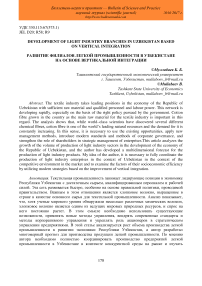Development of light industry branches in Uzbekistan based on vertical integration
Автор: Mullabaev Bachtijarzhan
Журнал: Бюллетень науки и практики @bulletennauki
Рубрика: Экономические науки
Статья в выпуске: 10 (23), 2017 года.
Бесплатный доступ
The textile industry takes leading positions in the economy of the Republic of Uzbekistan with sufficient raw material and qualified personnel and labour power. This network is developing rapidly, especially on the basis of the right policy pursued by the government. Cotton fibre grown in the country as the main raw material for the textile industry is important in this regard. The analysis shows that, while world-class scientists have discovered several different chemical fibres, cotton fibre is one of the world’s leading natural resources and the demand for it is constantly increasing. In this sense, it is necessary to use the existing opportunities, apply new management methods, introduce modern standards and methods of corporate governance, and strengthen the role of shareholders in strategic management of enterprises.This article analyzes the growth of the volume of production of light industry sectors in the development of the economy of the Republic of Uzbekistan, and the author has developed a multidimensional forecast for the production of light industry products. My idea of the author, it is necessary to fully coordinate the production of light industry enterprises in the context of Uzbekistan in the context of the competitive environment in the market and to examine the factors of their socioeconomic efficiency by utilizing modern strategies based on the improvement of vertical integration.
Vertical integration, light industry, standard, strategy, competitiveness, correlation, regression
Короткий адрес: https://sciup.org/14111249
IDR: 14111249 | УДК: 330.115:67(575.1) | DOI: 10.5281/zenodo.1012354
Список литературы Development of light industry branches in Uzbekistan based on vertical integration
- Cline W. The future of international trade in textiles and apparel. Washington: Institute for International Economics, 1992.
- Doeringer P., Crean S. Can fast fashion save the US apparel industry?//Socio-Economic Review. 2006. V. 4. №3. P. 353.
- Dickerson K. G. Textiles and apparel in the global economy (3rd Edition). Englewood Cliffts: Prentice-Hall, 1999.
- Nordas H. K. The global textile and clothing industry post the agreement on textiles and clothing//World and I. 2004. V. 7. №1.
- Verma S. Export competitiveness of Indian textile and garment industry//Indian Council for Research on International Economic Relations. Working paper. 2002. № 94.
- Juyoung L. Competitiveness of textile and apparel industries in the United States and Japan. Iowa State University. Digital Repository @ Iowa State University. Graduate Theses and Dissertations. 2013.
- Evgeniev E. Industrial and Firm Upgrading in the European Periphery: The Textile and Apparel Industry in Turkey and Bulgaria. Budapest: Central European University, 2006.
- Стацура А. И. Формирование и развитие конкурентоспособности предпринимательской структуры на рынке текстильной продукции: дисс.. канд. экон. наук. Санкт-Петербург, 2009. 138 с.
- Филюков К. Ю. Разработка механизма управления конкурентоспособностью предприятий легкой промышленности на основе совершенствования методологических подходов к ее оценке и регулированию: дисс.. канд. экон. наук. Санкт-Петербург, 2010. 174 с.
- Празян И. В. Маркетинговое обеспечение конкурентоспособности предприятий легкой промышленности: дисс. канд. экон. наук. Волгоград, 2007. 159 с.
- Фрадина Т. И. Методология и методы управления конкурентоспособностью предприятий легкой промышленности в условиях глобализации экономики: дисс.... д-ра экон. наук. Санкт-Петербург, 2010. 361 с.
- Искандеров И. И. Экономические проблемы развития текстильной промышленности в Узбекистане. Ташкент: Фан, 1969.
- Гулямов С. С. Управление производством. Ташкент, 2013
- Махмудов Н. Направления обеспечения сбалансированного развития легкой промышленности в Узбекистане//Республиканская конференция TDIU «Теоретические основы баланса образования и баланса между структурными компонентами экономики». 2008.
- Болтабоев М. Р. Маркетинговая стратегия в текстильной промышленности. Ташкент: Фан, 2004.


